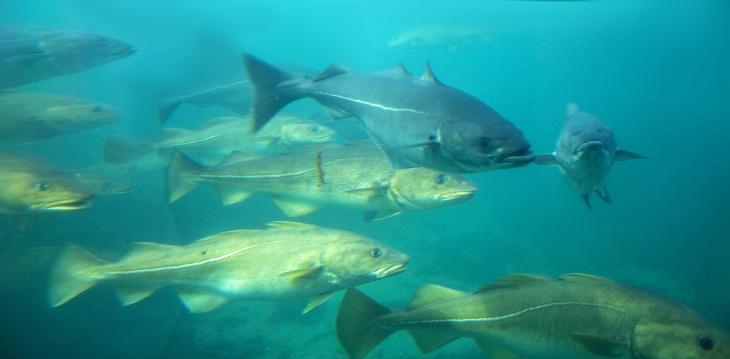Calculating the future of cod in the Barents Sea
Together with a Norwegian team of scientists, coastal researchers at Helmholtz-Zentrum Geesthacht have developed a statistical procedure that can help predict future cod stocks in the Barents Sea. This new method could sustainably improve cod fishery management on longer time scales and has now been published in the journal PLoS ONE.

A statistical procedure that will help predict future cod stocks in the Barents Sea
Photo: Fotolia/Vlada Z.
Cod is one of the most important food fish in the North Atlantic. Due to numerous influences, such as climate change or fishing pressure, scientific and environmental organizations have been issuing warnings about overfishing for years. To establish meaningful quotas, the International Council for Exploration of the Sea (ICES) regularly estimates cod stocks for the following one to three years. These predictions are based on knowledge concerning biology of the species, oceanographic parameters, such as salinity or water temperature, and human impact from fishing.
"We took a different approach in our forecasts and devoted ourselves solely to statistics in the Barents Sea," explains Prof Corinna Schrum, co-author and initiator of the current publication and director of the Institute for Coastal Research at the Helmholtz-Zentrum Geesthacht. For the first time, the team has achieved a long-term forecast that will allow stock prediction for up to seven years in advance. These forecasts are already more accurate than the ICES forecasts from the second year onwards.
![Barents Sea cod stock and upstream hydrography.
(a) Winter sea surface temperature [28] and schematic of the major ocean currents in and between the subpolar North Atlantic Ocean and the Nordic Seas. Abbreviations are defined in the inset legend. (b) Time series of observed Barents Sea cod stock (total stock biomass; TSB) and temperature anomalies from the Nordic Seas Atlas [29] along the Atlantic water pathways used as upstream hydrographic predictors. The AMO and SPG indexes are defined in Material and methods. All anomalies are relative to 1950–2012. The average travel times of observed hydrographic anomalies from the subpolar North Atlantic (represented by AMO/SPGi) to the Nordic Seas (FSC/IFR) and to the Barents Sea, and their lagged influence on the cod stock, are indicated (cf. Table 1).
© 2018 Årthun et al. doi.org/10.1371/journal.pone.0206319.g001 presentation of sea surface temperature and time series of observed cod stocks in the Barents Sea](/imperia/md/images/hzg/presse/pressemitteilungen/2018/fittosize__730_0_5877efc4e2754084292cf7771f46128a_barents-sea-cod-stock.jpg)
Barents Sea cod stock and upstream hydrography.
(a) Winter sea surface temperature [28] and schematic of the major ocean currents in and between the subpolar North Atlantic Ocean and the Nordic Seas. Abbreviations are defined in the inset legend. (b) Time series of observed Barents Sea cod stock (total stock biomass; TSB) and temperature anomalies from the Nordic Seas Atlas [29] along the Atlantic water pathways used as upstream hydrographic predictors. The AMO and SPG indexes are defined in Material and methods. All anomalies are relative to 1950–2012. The average travel times of observed hydrographic anomalies from the subpolar North Atlantic (represented by AMO/SPGi) to the Nordic Seas (FSC/IFR) and to the Barents Sea, and their lagged influence on the cod stock, are indicated (cf. Table 1).
© 2018 Årthun et al. doi.org/10.1371/journal.pone.0206319.g001
Temperature and salinity ratios in the North Atlantic are subject to long-term fluctuations that can range from a few years to decades. For developing their successful analyses, the German-Norwegian team of scientists statistically compared the biomass of cod stocks in the Barents Sea between 1957 and 2017 with observational data on temperature and salinity in the North Atlantic. The results showed that these fluctuations in the North Atlantic have a clear connection with the future cod stocks in the Barents Sea and have a lasting effect.
"We suspect that more warm and nutrient-rich water in the Barents Sea from the North Atlantic leads to increased food production for the cod and thus increases the biomass of the stock in ‘warm’ years," explains Corinna Schrum.
"We hope that our successful work can contribute to more sustainable management of cod stocks in the Barents Sea," Schrum says.
The model developed by the scientists predicts a progressive decrease in cod biomass in the Barents Sea by 2024.
Publication
Årthun M, Bogstad B, Daewel U, Keenlyside NS, Sandø AB, et al. (2018) Climate based multi-year predictions of the Barents Sea cod stock. PLOS ONE 13(10): e0206319.
Climate based multi-year predictions of the Barents Sea cod stock
Contact
Institute of Coastal Research
Phone: +49 (0)4152 87-1833
Fax: +49 (0)4152 87-2832
E-mail contactHelmholtz-Zentrum Geesthacht
Helmholtz-Zentrum Geesthacht
